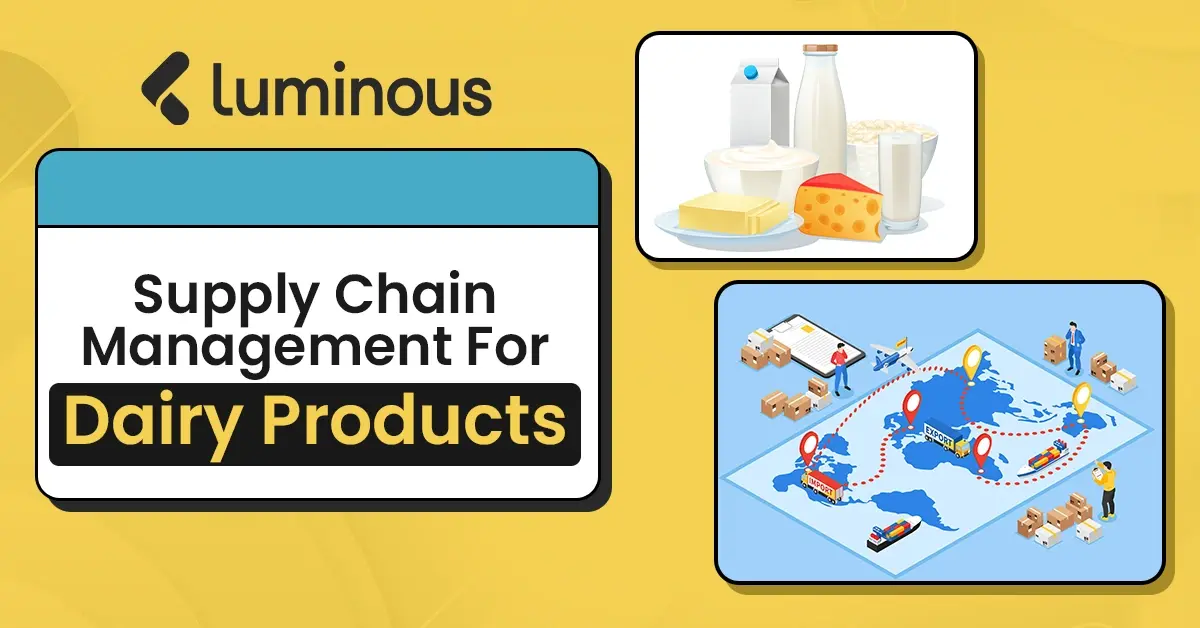Supply Chain Management For Dairy Products

When you pour a glass of milk or enjoy a slice of cheese, have you ever wondered about the journey these dairy products take from the farm to your table? The dairy supply chain is a complex network of processes, and managing it comes with its own set of challenges. In this article, we'll explore the intricacies of dairy supply chain management, why it's a challenging task, and how it's done.
Challenges of Dairy Supply Chain
Perishability
Dairy products are renowned for their freshness and nutritional value, but this very characteristic makes them highly perishable. Milk, cheese, and other dairy items can spoil quickly if not handled with care. This means that maintaining the cold chain—keeping these products at the right temperature from farm to store—is absolutely critical. Any deviation from the ideal conditions can result in spoilage and waste.
Fluctuations in Demand
Another significant challenge in the dairy supply chain is the fluctuation in demand. Dairy consumption patterns can vary significantly based on the time of year, holidays, and even unexpected events like a global pandemic. Managing this variability requires a delicate balance between production and inventory management. Too much milk in stock can lead to spoilage, while too little can result in shortages and lost sales.
Geographic Dispersion
The dairy supply chain often spans large geographic areas. Dairy farms are situated in rural regions, while processing facilities and distribution centers might be located in urban or suburban areas. This dispersion adds complexity to logistics and transportation. Coordinating the movement of raw milk from farms to processing plants and then distributing finished products to retailers or consumers demands efficient planning and transportation networks.
Regulatory Compliance
The dairy industry is heavily regulated to ensure the safety and quality of products. Compliance with these regulations is a significant challenge for supply chain managers. Regulations cover everything from hygiene standards at farms and processing plants to labeling requirements on dairy products. Non-compliance can result in fines, recalls, and damage to a brand's reputation.
Supply Chain Management of Dairy Milk
The supply chain management of dairy milk involves several critical stages:
Milk Collection
The journey of milk begins at dairy farms, where it is collected from cows. Large dairy farms typically have their own milk collection facilities, while smaller ones rely on cooperatives or dairy processors to collect their milk. This collected milk must be transported to processing facilities swiftly to maintain freshness.
Transportation
Transportation is a key element of dairy supply chain management. Milk must be transported from farms to processing plants quickly and under controlled temperature conditions. Specialized dairy tankers or refrigerated trucks are used for this purpose to prevent spoilage.
Pasteurization and Processing
Once milk reaches the processing facility, it undergoes pasteurization and other processing steps to ensure safety and extend shelf life. Pasteurization, in particular, involves heating the milk to kill harmful bacteria while preserving its taste and nutritional value.
Packaging
After processing, dairy milk is packaged in various forms, such as bottles, cartons, or bags, ready for distribution. Packaging plays a crucial role in maintaining product freshness and preventing contamination.
Distribution
Dairy products are distributed to retailers or consumers through a well-organized logistics network. Tracking systems help monitor product movement and ensure timely delivery. Efficient distribution is essential to meet consumer demand while maintaining product quality.
Risks of Milk Supply Chain
The milk supply chain faces several risks that must be mitigated:
Contamination Risks
Contamination is a significant concern in the dairy industry. Any contamination of milk or dairy products can lead to health hazards and damage a brand's reputation. Rigorous hygiene practices and regular quality checks are essential to prevent contamination.
Spoilage
Spoilage can occur due to transportation delays, improper handling, or failure to maintain the cold chain. Preventing spoilage is not only critical for reducing waste but also for ensuring the freshness and safety of dairy products.
Market Price Fluctuations
The dairy industry is subject to market price fluctuations, often influenced by factors like supply and demand, weather conditions, and global events. These fluctuations can impact the profitability of dairy businesses, necessitating flexible pricing and sourcing strategies.
Challenges of Dairy Production
Dairy production, the initial step in the supply chain, has its own share of challenges:
Fluctuating Milk Yields
Milk production is influenced by various factors, including seasonal changes, weather conditions, and the health of dairy animals. Dairy farmers must adapt to these fluctuations in milk yields to maintain a consistent supply.
Animal Well-being
Ensuring the well-being of dairy animals is not only an ethical concern but also essential for sustainable dairy production. Healthy cows produce better-quality milk, and dairy farmers must invest in their care and health.
Hygiene Standards
Maintaining high hygiene standards during milk production is essential to prevent contamination. This includes cleanliness at the milking parlor, proper handling of milk, and ensuring the health and hygiene of dairy animals.
Conclusion
In conclusion, managing the dairy supply chain is a multifaceted task that requires careful planning, coordination, and adherence to regulations. The challenges of perishability, demand fluctuations, geographic dispersion, and regulatory compliance demand constant vigilance. Supply chain managers must also navigate the complexities of coordination, product safety, and market dynamics.
Yet, the dairy industry continues to thrive, thanks to advanced technologies, innovative practices, and the dedication of those involved at every stage of the supply chain. By ensuring that dairy products reach consumers fresh and safe, the industry continues to provide us with the dairy delights we enjoy daily.

